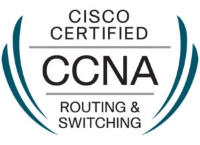COURSE MODULES AND OBJECTIVES
The complete CCNA VERSION 7 offered at AFRALTI covers the following three (3) parts:
- CCNA1 – Introduction to Networks (ITN)
- CCNA2 – Switching, Routing and Wireless Essentials (SRWE)
- CCNA3 – Enterprise Networking, Security, and Automation (ENSA)
CCNA 1: Introduction to Networks (ITN) – Objectives
This course introduces the architectures, models, protocols, and networking elements that connect users, devices, applications and data through the internet and across modern computer networks – including IP addressing and Ethernet fundamentals. By the end of the course, students can build simple local area networks (LANs) that integrate IP addressing schemes, foundational network security, and perform basic configurations for routers and switches. Students who complete Introduction to Networks will be able to perform the following functions:
- Explain the advances in modern network technologies.
- Implement initial settings including passwords, IP addressing, and default gateway parameters on a network switch and end devices.
- Explain how network protocols enable devices to access local and remote network resources.
- Explain how physical layer protocols, services, and network media support communications across data networks.
- Calculate numbers between decimal, binary, and hexadecimal systems.
- Explain how media access control in the data link layer supports communication across networks.
- Explain how Ethernet operates in a switched network.
- Explain how routers use network layer protocols and services to enable end-to- end connectivity.
- Explain how ARP and ND enable communication on a network.
- Implement initial settings on a router and end devices.
- Calculate an IPv4 subnetting scheme to efficiently segment a network.
- Implement an IPv6 addressing scheme.
- Use various tools to test network connectivity.
- Compare the operations of transport layer protocols in supporting end-to-end communication.
- Explain the operation of application layer protocols in providing support to end-user applications.
- Configure switches and routers with device hardening features to enhance security.
- Implement a network design for a small network to include a router, a switch, and end devices.
CCNA 2: Switching, Routing and Wireless Essentials (SRWE) – Objectives
This course in the CCNA curriculum focuses on switching technologies and router operations that support small-to-medium business networks and includes wireless local area networks (WLANs) and security concepts. Students learn key switching and routing concepts. They can perform basic network configuration and troubleshooting, identify and mitigate LAN security threats, and configure and secure a basic WLAN. Students who complete Switching, Routing and Wireless Essentials Course will be able to perform the following functions:
- Configure devices by using security best practices.
- Explain how Layer 2 switches forward data.
- Implement VLANs and trunking in a switched network.
- Troubleshoot inter-VLAN routing on Layer 3 devices.
- Explain how STP enables redundancy in a Layer 2 network
- Troubleshoot EtherChannel on switched links.
- Implement DHCPv4 to operate across multiple LANs.
- Configure dynamic address allocation in IPv6 networks.
- Explain how FHRPs provide default gateway services in a redundant network.
- Explain how vulnerabilities compromise LAN security.
- Implement switch security to mitigate LAN attacks.
- Explain how WLANs enable network connectivity.
- Implement a WLAN using a wireless router and WLC.
- Explain how routers use information in packets to make forwarding decisions.
- Configure IPv4 and IPv6 static routes.
- Troubleshoot static and default route configurations.
CCNA 3: Enterprise Networking, Security, and Automation (ENSA) – Objectives
This course in the CCNAv7 curriculum describes the architectures and considerations related to designing, securing, operating, and troubleshooting enterprise networks. This course covers wide area network (WAN) technologies and quality of service (QoS) mechanisms used for secure remote access. ENSA also introduces software-defined networking, virtualization, and automation concepts that support the digitalization of networks. Students gain skills to configure and troubleshoot enterprise networks, and learn to identify and protect against cybersecurity threats. They are introduced to network management tools and learn key concepts of software-defined networking, including controller-based architectures and how application programming interfaces (APIs) enable network automation. Students who complete the Enterprise Networking, Security, and Automation will be able to perform the following functions:
- Explain how single-area OSPF operates in both point-to-point and broadcast multiaccess networks.
- Implement single-area OSPFv2 in both point-to-point and broadcast multiaccess networks.
- Explain how vulnerabilities, threats, and exploits can be mitigated to enhance network security.
- Explain how ACLs are used as part of a network security policy.
- Implement IPv4 ACLs to filter traffic and secure administrative access.
- Configure NAT services on the edge router to provide IPv4 address scalability.
- Explain how WAN access technologies can be used to satisfy business requirements.
- Explain how VPNs and IPsec secure site-to-site and remote access connectivity.
- Explain how networking devices implement QoS.
- Implement protocols to manage the network.
- Explain the characteristics of scalable network architectures.
- Troubleshoot enterprise networks.
- Explain the purpose and characteristics of network virtualization.
- Explain how network automation is enabled through RESTful APIs and configuration management tools.
Course Facilitators
This course is delivered by highly skilled and experienced Cisco Certified Academy Instructors (CCAIs) who have also attained the CCNA, CCNA Security, CCNP, CCIE, among other related certifications.


